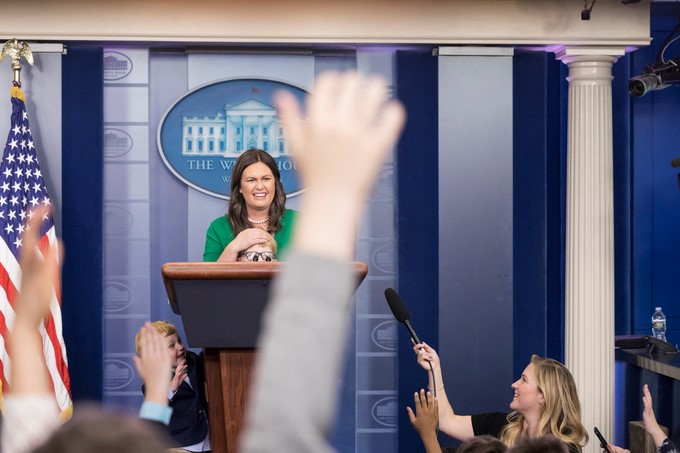There’s no denying that we currently live in an age of social media, where Twitter serves as the main method of communication between the leader of the free world and his electorate; yet the White House press briefing remains the traditional channel of nationally relevant news directly from the administration. These press briefings feature a Q&A format, during which correspondents from nationally syndicated media outlets can ask questions that have not been addressed by the administration. The Q&A format of the briefing is intended to create a dialogue that’s both rehearsed and extemporaneous; while press secretaries are trained to craft careful responses and answer at their discretion, the direction of the conversation is determined by the press corps and the questions the Secretary takes. The cameras and microphones might be on the podium, but the content of the dialogue remains in the hands of the press.
As the Trump administration threatens to abolish press briefings altogether, a historical analysis of the press briefing in America’s politicized media landscape illuminates what this disappearance could mean for the future of White House communications. In order to analyze trends, press briefings from 1993 to 2018 were separated by year and speaker (press secretary or press corps), then analyzed with a natural language processing software known as the Linguistic Inquiry and Word Count (LIWC). The LIWC is designed to capture important linguistic, psychological, and social processes in samples of text. The algorithm reports on a range of metrics, including the degree of perceived authenticity, analytical thinking, expertise, and emotional tone of the speaker, as well as male and female references and orientation of language toward the past, present, or future.
President Trump often alleges that newspapers and the news media have treated him differently from past presidents. With regards to press briefings, this complaint has limited, though not insubstantial, merit. According to the LIWC authenticity metric, the questions asked by the media of President Trump’s press secretaries reflect a more guarded, distant stance toward the president and his administration. Results for the other three metrics, however, indicate that the press has approached the current administration with similar levels of confidence, expertise, and intellectual rigor when compared with previous administrations. In fact, exhibited positivity by the press corps toward the press secretaries is currently higher than it had been in the Obama administration. While this increase in positivity might be surprising, this trend may reflect a constructive adjustment by the press toward President Trump’s press secretaries, Sean Spicer and Sarah Sanders, whose lower analytical scores reflect more informal, off-the-cuff styles of speech. Decreases in the analytical language of the secretaries may be in response to President Trump’s highly personal, informal style of rhetoric.
Despite increasing positivity levels amongst the press corps during recent press briefings, the current administration is threatening to discontinue or diminish this time-honored tradition. This risk should be of great concern: In an era of fake news and misinformation, the White House press briefing is a particularly important channel of direct communication between the White House and the people. Nevertheless, the presidential press briefing has been in decline in both duration and frequency under the Trump administration. From June to August 2018, Sarah Sanders, the current press secretary, spent 3 hours and 58 minutes behind the podium. Comparatively, the Obama administration held approximately 39 hours of formal Q&A during an equivalent period in the summer of 2016. More recently, Sanders held just one briefing in September 2018, two in October, and one in November—traditionally, press briefings happen on a daily basis. While press briefings have certainly fluctuated in frequency and duration since they first became regular occurrences in 1993, the current administration’s lack of regard for the importance of the briefings signals a clear break from tradition and disinterest in directly informing the people of day-to-day administrative efforts. In recent years, social media has undoubtedly transformed the national political dialogue. Given this trend, Trump’s preference for Twitter over formal briefings could be a careful strategy to secure more personal control over political discourse. Sanders defends the president, stating that he “directly engages and is more accessible to the press than any president before him.” But as more informal channels of communication continue to replace the validity and professionalism that press briefings demand, the White House is increasingly becoming the exclusive author of its own national narrative.
Photo: “Sarah Huckabee Sanders“
